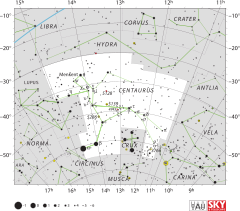| Observation data Epoch J2000.0 Equinox J2000.0 | |
|---|---|
| Constellation | Centaurus |
| Right ascension | 13h 55m 32.38565s [1] |
| Declination | −47° 17′ 18.1482″ [1] |
| Apparent magnitude (V) | +2.55 [2] |
| Characteristics | |
| Spectral type | B2.5 IV [3] |
| U−B color index | −0.91 [2] |
| B−V color index | −0.22 [2] |
| Astrometry | |
| Radial velocity (Rv) | +6.5 [4] km/s |
| Proper motion (μ) |
RA: −57.37
[1]
mas/
yr Dec.: −44.55 [1] mas/ yr |
| Parallax (π) | 8.54 ± 0.13 mas [1] |
| Distance | 382 ± 6
ly (117 ± 2 pc) |
| Absolute magnitude (MV) | −2.79 [5] |
| Orbit [6] | |
| Period (P) | 8.024 days |
| Semi-major axis (a) | 0.0014 " [7] |
| Eccentricity (e) | 0.5 |
| Periastron epoch (T) | 2413719.321 JD |
|
Argument of periastron (ω) (secondary) | 290° |
| Details | |
| Mass | 7.8±0.1 [3] M☉ |
| Radius | 5.80±0.53 [8] R☉ |
| Surface gravity (log g) | 3.84±0.08 [8] cgs |
| Temperature | 23561±283 [8] K |
| Rotational velocity (v sin i) | 235 [9] km/s |
| Age | 39.8±5.7 [3] Myr |
| Other designations | |
| Database references | |
| SIMBAD | data |
Zeta Centauri, Latinized from ζ Centauri, is a binary star system in the southern constellation of Centaurus. It has the proper name Alnair /æˈnɛər/, from Arabic: نير بطن قنطورس, romanized: nayyir baṭan qanṭūris, lit. 'the bright (star) of the body of the centaur'. [11] [12] With a combined apparent visual magnitude of +2.55, [2] it is one of the brighter members of the constellation. This system is close enough to the Earth that its distance can be measured directly using the parallax technique. This yields a value of roughly 382 light-years (117 parsecs), with a 1.6% margin of error. [1] It is drifting further away with a radial velocity of +6.5 km/s. [4]
In Chinese, 庫樓 (Kù Lóu), meaning Arsenal, refers to an asterism consisting of ζ Centauri, η Centauri, θ Centauri, 2 Centauri, HD 117440, ξ1 Centauri, γ Centauri, τ Centauri, D Centauri and σ Centauri. [13] Consequently, the Chinese name for ζ Centauri itself is 庫樓一 (Kù Lóu yī, English: the First Star of Arsenal.) [14]
ζ Cen is a double-lined spectroscopic binary system, [15] which indicates that the orbital motion was detected by shifts in the absorption lines of their combined spectra caused by the Doppler effect. The two stars orbit each other over a period of slightly more than eight days with an orbital eccentricity of about 0.5. [6] The estimated angular separation of the pair is 1.4 mas. [7]
At an estimated age of 40 million years, [3] the primary component of this system appears to be in the subgiant stage of its evolution with a stellar classification of B2.5 IV. [3] It is a large star with nearly 8 [3] times the mass of the Sun and close to 6 [8] times the Sun's radius. This star is rotating rapidly with a projected rotational velocity of 235 km s−1. [9]
References
- ^ a b c d e f van Leeuwen, F. (November 2007), "Validation of the new Hipparcos reduction", Astronomy and Astrophysics, 474 (2): 653–664, arXiv: 0708.1752, Bibcode: 2007A&A...474..653V, doi: 10.1051/0004-6361:20078357, S2CID 18759600
- ^ a b c d Johnson, H. L.; et al. (1966), "UBVRIJKL photometry of the bright stars", Communications of the Lunar and Planetary Laboratory, 4 (99): 99, Bibcode: 1966CoLPL...4...99J
- ^ a b c d e f Tetzlaff, N.; Neuhäuser, R.; Hohle, M. M. (January 2011), "A catalogue of young runaway Hipparcos stars within 3 kpc from the Sun", Monthly Notices of the Royal Astronomical Society, 410 (1): 190–200, arXiv: 1007.4883, Bibcode: 2011MNRAS.410..190T, doi: 10.1111/j.1365-2966.2010.17434.x, S2CID 118629873
- ^ a b Wilson, R. E. (1953), "General Catalogue of Stellar Radial Velocities", Carnegie Institute Washington D.C. Publication, Carnegie Institute of Washington D.C., Bibcode: 1953GCRV..C......0W
- ^ Anderson, E.; Francis, Ch. (2012), "XHIP: An extended hipparcos compilation", Astronomy Letters, 38 (5): 331, arXiv: 1108.4971, Bibcode: 2012AstL...38..331A, doi: 10.1134/S1063773712050015, S2CID 119257644.
- ^ a b Maury, A. C. (1922), "The Orbit of the Spectroscopic Binary ζ Centauri", Harvard College Observatory Circular, 233: 1–4, Bibcode: 1922HarCi.233....1M
- ^ a b Halbwachs, J. L. (April 1981), "List of Estimated Angular Separations of Spectroscopic Binaries", Astronomy and Astrophysics Supplement, 44: 47, Bibcode: 1981A&AS...44...47H
- ^ a b c d Fitzpatrick, E. L.; Massa, D. (March 2005), "Determining the Physical Properties of the B Stars. II. Calibration of Synthetic Photometry", The Astronomical Journal, 129 (3): 1642–1662, arXiv: astro-ph/0412542, Bibcode: 2005AJ....129.1642F, doi: 10.1086/427855, S2CID 119512018
- ^ a b Bernacca, P. L.; Perinotto, M. (1970), "A catalogue of stellar rotational velocities", Contributi Osservatorio Astronomico di Padova in Asiago, 239 (1): 1, Bibcode: 1970CoAsi.239....1B
- ^ "* zet Cen". SIMBAD. Centre de données astronomiques de Strasbourg. Retrieved 2012-03-01.
- ^ Kunitzsch, P.; Smart, T. (2006), A Dictionary of Modern star Names: A Short Guide to 254 Star Names and Their Derivations (2nd revised ed.), Cambridge, MA: Sky Pub, p. 4, ISBN 978-1-931559-44-7
- ^ ibid., p.28.
- ^ (in Chinese) 中國星座神話, written by 陳久金. Published by 台灣書房出版有限公司, 2005, ISBN 978-986-7332-25-7.
- ^ (in Chinese) AEEA (Activities of Exhibition and Education in Astronomy) 天文教育資訊網 2006 年 7 月 25 日
- ^ van Rensbergen, W.; De Loore, C.; Jansen, K. (February 2006), "Evolution of interacting binaries with a B type primary at birth", Astronomy and Astrophysics, 446 (3): 1071–1079, Bibcode: 2006A&A...446.1071V, doi: 10.1051/0004-6361:20053543
